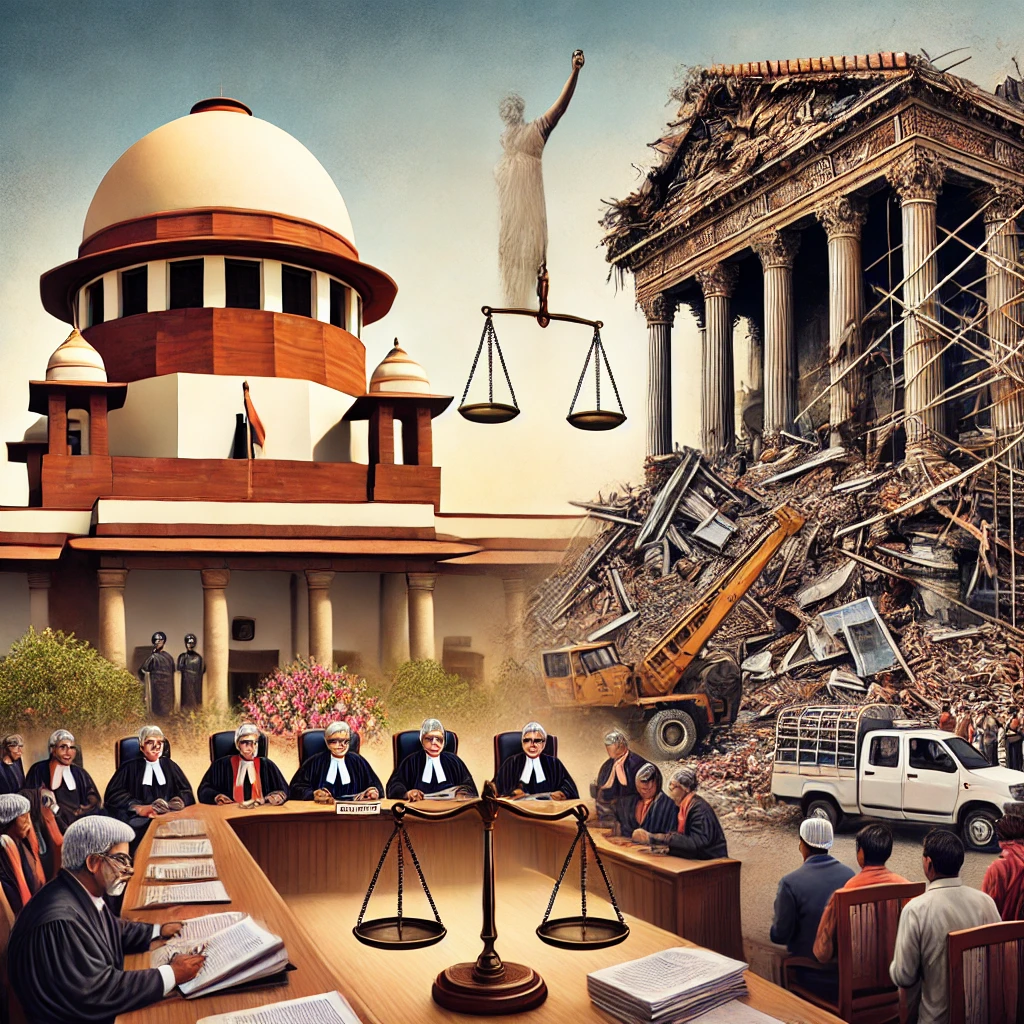
Tanu Sharma is currently in her third year of study for a BA LLB (Hons) at GGU, Central University of Chhattisgarh, Read More

IN THE SUPREME COURT OF INDIA
CIVIL/CRIMINAL ORIGINAL JURISDICTION
WRIT PETITION (CIVIL) NO.295 OF 2022
In Re: Directions in the matter of demolition of structures
WITH
WRIT PETITION (CRIMINAL) NO. 162 OF 2022
WRIT PETITION (CIVIL) NO. 328 OF 2022
- CITATION – 2024 INSC 866
- DATE OF JUDGEMENT – NOVEMBER 13, 2024
- BENCH – HON’BLE MR. JUSTICE B.R GAVAI & HON’BLE MR. JUSTICE K. V. VISWANATHAN
- JUDGEMENT- HON’BLE MR. JUSTICE B.R GAVAI
INTRODUCTION
The case of In Re: Directions in the Matter of Demolition of constructions v. and Ors. is an important legal challenge to the practice of demolishing constructions in India without adequate legal procedures. The issue originated from a series of unauthorised demolitions, notably in the aftermath of communal riots in Delhi in 2022. The demolitions generated significant demonstrations and raised concerns about selective targeting and a lack of due process.
The petitioners claimed that the demolitions breached basic rights, such as the right to property and equality. They said that such activities should be subject to stringent judicial review, including prior notice and the right to be heard. The case has far-reaching consequences for property rights, the rule of law, and the safety of vulnerable people.
The Court acknowledged the anguish that hurried demolitions cause, especially to vulnerable populations like women, children, and the elderly, and declared that demolitions must not take place before providing impacted parties with sufficient time to either leave and make other arrangements or contest the demolition order in a suitable forum. According to the Court, “Heavens would not fall on the authorities if they hold their hands for some period,” supporting a methodical and compassionate approach to demolition cases.
FACTS
In the Indian Supreme Court, the case “In Re: Directions in the Matter of Demolition of Structures” was filed as a Public Interest Litigation (PIL). Several incidents in which state officials demolished residential and commercial buildings in different Indian states provided the setting for this lawsuit. Criminal charges against the property owners were allegedly connected to these demolitions.
PIL Initiation– Several activists and people petitioned the Supreme Court, claiming that the demolitions were carried out without adhering to the proper legal procedures. Among other things, this involved not giving the impacted parties advance notice or a chance to be heard.
Article 32 of the Indian Constitution-The petitions were submitted in accordance with Article 32, which permits people to look for solutions to ensure that their fundamental rights are upheld. According to the plaintiffs, the demolitions infringed upon their constitutional rights to due process and shelter under Articles 21 (Right to Life) and 300A (Right to Property).
Precipitative activities– The main complaint was that, in the absence of a court order or other legal process approving such actions, demolitions were being carried out as punitive measures against those who were allegedly guilty of crimes.
Intervention of the Court-After considering these concerns, the Supreme Court issued temporary orders to prevent any more demolitions without following the proper procedures. The Court underlined the need of adhering to the law and making sure that the accused’s and property owners’ rights are upheld.
Jahangirpuri Demolitions-The demolitions following communal violence in Jahangirpuri, Delhi, in 2022, sparked widespread protests and legal challenges.
In essence, the case centered around the violation of fundamental rights, the importance of due process, and the need to prevent the misuse of state power in matters of property demolition.
ALSO READ:
An Analysis of the Bulldozer Judgment: Safeguarding Constitutional Principles
ISSUES
- Whether demolition of property without due to process of law is the violation of fundamental rights?
- Whether the executive’s authority to act as both the accuser and the punisher violated the principle of separation of power?
- The arbitrary and unauthorized demolitions raised concerns about the rule of law and the potential for misuse of state power.
ARGUMENTS OF THE PETITIONER
Here are the brief of petitioner’s arguments presented in the case In Re: Directions in the Matter of Demolition of Structures vs. Ors-
- Violation of Fundamental Rights
Property Rights- The petitioners said that the demolitions infringed against the Indian Constitution’s Article 300A, which guarantees the basic right to property.
Article 21 guarantees the right to life and liberty, which includes the right to shelter as a fundamental element.
Due procedure- It was believed that the demolition procedure violated the rights to due process and natural justice. This was because there was insufficient notice, hearings, and court supervision.
- Separation of Powers
In this instance, the executive’s dual role as the accuser and the punisher was contested. Property demolition without court supervision was viewed as an infringement on the judiciary’s authority to decide guilt and administer punishments.
- Rule of Law
There were worries about the rule of law and the possibility of abuse of governmental authority due to the arbitrary and unapproved demolitions.
- Social Justice
The lawsuit raised issues of equality before the law and social justice by demonstrating how these demolitions disproportionately affect underprivileged areas.
- State Official Accountability
The lawsuit aimed to create procedures for holding state officials accountable for illegal demolitions.
ARGUMENTS OF THE RESPONDENT
The respondents in In Re: Directions in the subject of Demolition of Structures v. and Ors. would have made the following claims on behalf of the government agencies in charge of the demolitions-
- Maintenance of Law and Order
In order to preserve law and order, stop more acts of violence, and safeguard public safety, the respondents would contend that the demolitions were required.
They could include examples of circumstances in which the buildings were utilised illegally or endangered public safety.
- Enforcement of Municipal Laws
Many of the buildings that were demolished were probably constructed unlawfully or in violation of current building rules and local ordinances, according to the replies.
In order to guarantee appropriate urban planning and public safety, they would stress the necessity of enforcing these standards.
- National Security Concerns
In certain instances, the respondents can contend that the demolitions were required for national security reasons, such stopping the use of buildings for terrorist activity or as havens for criminals.
- Limited Scope of Judicial Review
In cases involving law and order and national security, the respondents may contend that the court ought to respect the executive’s judgement.
They could argue that unless it is obviously capricious or dishonest, the court shouldn’t get involved in a lawful government activity.
- Procedural Safeguards
The respondents may contend that, given the urgency of the case, acceptable processes were followed to the greatest degree practicable while understanding the significance of due process.
COURT’S REASONING
The court’s reasoning in In Re: Directions in the matter of Demolition of Structures v. and Ors. would likely center around the following-
- Protection of Fundamental Rights-The court would place a strong emphasis on the importance of fundamental rights, especially the rights to equality, free will, and property. if the demolitions were warranted and if they unfairly damaged the rights of the impacted persons would probably be examined.
- Rule of law and due process- The court would emphasise the significance of due process, which includes the rights to judicial review, notice, and hearing. It would look into whether the demolitions respected the rule of law and were done in compliance with established legal processes.
- Separation of authorities-The court would probably stress how crucial it is to keep the legislative, executive, and judicial departments’ authorities separate. It would examine if the demolitions were carried out legally and if the executive branch overreached itself by serving as both the complainant and the punisher.
- Necessity and Proportionality-The court would probably determine whether the demolitions were the least restrictive way to accomplish the intended goal and if they were commensurate to the accused offences.
- Social Justice-The court would probably take into account how the demolitions would affect marginalised populations in particular on a social and economic level and make sure that the state’s actions don’t make already-existing disparities worse.
The court’s rationale sought to ensure that demolitions are not employed as punitive measures without a valid reason by striking a balance between the state’s interest in upholding public order and the protection of individual rights.
PRECEDENT ANALYSIS
The case In Re: Directions in the Matter of Demolition of Structures vs. Ors sets a significant precedent in the context of due process and the protection of fundamental rights in India. Here are some key aspects of the precedent analysis-
- Due process and the rule of law– The Supreme Court’s ruling emphasises how crucial it is to follow these guidelines before performing demolitions. For future instances where state officials could try to evade the judicial system, this establishes a precedent.
- Separation of Powers– By emphasizing the separation of powers between the executive and judiciary, the court ensures that state authorities cannot act arbitrarily without judicial oversight. This precedent is crucial for maintaining checks and balances in governance.
- Public Accountability-The court’s order to take severe measures against authorities responsible for unlawful demolitions emphasises how crucial public accountability is. Holding public servants accountable for their deeds is established by this precedence.
- Protection of Fundamental Rights-The ruling emphasises the importance of protecting fundamental rights, especially the rights to due process and shelter. Future cases pertaining to the rights of people accused in criminal proceedings will be guided by this precedent.
- Collective Punishment- The court’s opposition to collective punishment, which involves demolishing the homes of innocent citizens in addition to the convicted, establishes a standard for making sure that punitive actions are not utilised arbitrarily.
This precedent analysis demonstrates how the Supreme Court’s ruling in this case fortifies the legal foundation for safeguarding individual liberties and guaranteeing state accountability.
JUDGEMENT
The judgment in the case In Re: Directions in the Matter of Demolition of Structures can be summarized as follows-
- Precipitative Action Prohibition-The Supreme Court ordered state officials to refrain from destroying the properties of those who are charged without first completing due process.
- Ensuring responsibility-To ensure responsibility and compliance with legal processes, the court ordered severe penalties against authorities involved in unlawful demolitions.
- Exceptions to Directions- The court made it clear that unpermitted buildings situated in public areas like streets, pavements or roadways are exempt from these directives.
- Emphasis on the Right to Shelter- The ruling emphasised the importance of having due process followed before demolition may take place, as well as the fundamental right to shelter.
This ruling sets a crucial precedent for maintaining the rule of law and defending people’s rights from capricious official acts.
ANALYSIS
For demolitions in the future, the case establishes a crucial legal precedent that requires due process and individual rights to be respected.
- The legal framework for the protection of property and refuge is strengthened.
- There are important ramifications for public policy, especially when it comes to law enforcement and urban development.
- Social Impact makes sure that demolitions are not used as punitive measures without a valid reason by highlighting the value of shelter and the effects they have on people and families.
In order to ensure justice and accountability in the application of the law, this study demonstrates how the Supreme Court’s ruling strikes a balance between the protection of individual rights and state interests.
CONCLUSION
The Supreme Court of India rendered a significant ruling in the case “In Re: Directions in the Matter of Demolition of Structures.” To guarantee that demolitions are conducted in accordance with due process of law and to safeguard the rights of those who are accused in criminal proceedings, the court issued a number of important directives.
Prohibition of Precipitative Actions-The court forbade state officials from acting without due process in a precipitous manner against the possessions of those who were accused.
Accountability- The court ordered authorities involved in unlawful demolitions to face severe consequences.
Exceptions- Unauthorised buildings on roadways, sidewalks, and other public areas are exempt from the guidelines. The court placed a strong emphasis on the value of shelter and the necessity of following the law before demolishing a property.
The balance between law enforcement operations and the defence of basic rights is highlighted by this ruling, which makes sure that demolitions are not employed as punitive measures without a valid reason.
Property rights, individual liberty, and the distribution of power among the many departments of government would all be significantly impacted by the case’s verdict. It would help guarantee that property demolitions are carried out legally and with appropriate consideration for human rights, and it would set a precedent for similar situations in the future.






